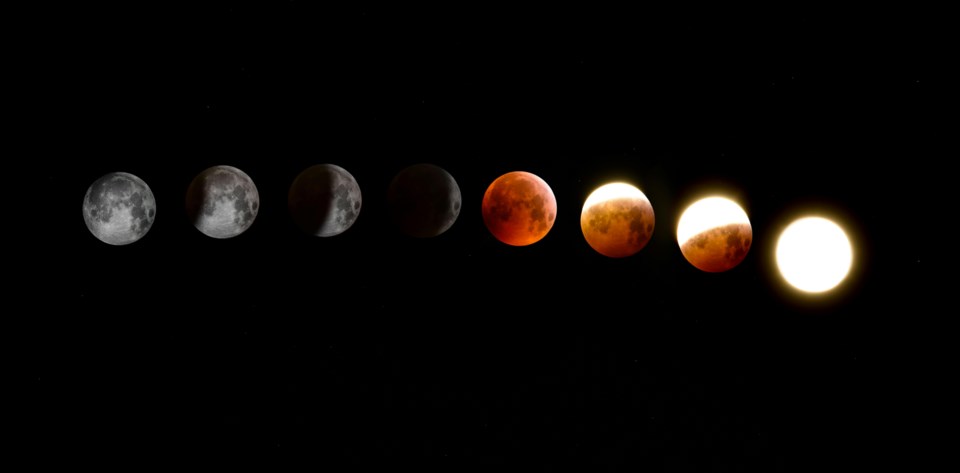For the most part, all the planets orbit the sun in the same plane.
Mercury’s orbit is slightly tilted in relation to the others. Our moon also orbits earth in this same plane.
That means the moon occasionally comes between us and the sun, putting us in shadow.
That is a solar eclipse.
From time to time, the Earth’s shadow falls on the moon, known as a lunar eclipse.
Consider the solar eclipse, which is expected on the afternoon of April 8, 2024.
The moon is well sized to block the sun. Its orbit isn’t perfectly circular, so its distance from Earth varies. When the moon is closest to us, it completely covers the sun, but only when viewed from certain locations. This is a total eclipse. When it is farther away, the moon looks smaller.
The size of the moon from Earth appears to vary by 13 per cent. Then, coverage of the sun’s disc is incomplete, leaving a thin ring of light around the moon’s shadow. This is an annular eclipse.
On April 8, parts of southern Ontario will be treated to a total solar eclipse. The band of totality will straddle Lakes Erie and Ontario, and also the St. Lawrence valley. The moon first moves into position to shade us from the sun.
This shadow moves northeast, leaving North America over Newfoundland. This NASA map traces its path across North America.
In southern Ontario, the fun begins just before 2 p.m. in Windsor. This link to an animated map shows the eclipse as it develops for various cities across our region, ending in Cornwall at around 4:45 p.m.
Hamilton, Niagara Falls, Kingston and Cornwall will see a total eclipse. Toronto is just outside what's known as the path of totality, but will see 99 per cent totality. Montreal is on the edge of totality, too.
The Barrie area is farther away and will get 97 per cent totality. But, still well worth the effort of checking it out.
Altogether, Canada gets about 30 minutes of eclipse – but only if we are blessed with a clear, cloudless sky. Of course, it is far too early to tell if that will be the case.
And don't forget about safety. Looking at the sun directly and without protection can damage the eyes seriously and permanently. You must use eye protection!
Probably, the best eye protection can be had by wearing special “eclipse eye glasses.”
I have not used any of these and cannot recommend a brand. Barrie opticians may have some for sale. If you ask in advance, they may get a pair in for you.
It is possible to protect your eyes without buying special glasses, though. The darkest “windows” for a welder’s helmet did the job for me. I bought two at a welding supply shop. If one wasn’t dark enough, I could tape both together, but this wasn’t necessary.
Try them before buying by stepping outside and looking at the sun – very briefly – until you are certain they work well. You must be able to look at the sun without squinting.
If you have binoculars, cover the lenses with aluminum foil and use adhesive tape to secure the foil. With a needle, make a small hole in the centre of the foil. Test it by looking at the sun – very briefly. If this lets in too much light, the hole is too large. It is unlikely that the image isn’t bright enough, but if it is, you can enlarge the holes, but only slightly and carefully.
Personal experience
A half-century ago, I drove 200 kilometres north of Nairobi, where I was working, to view a mid-afternoon total eclipse.
We were in a semi-desert area, teeming with gazelle and zebra. As the sun darkened, the animals began to race back and forth, clearly realizing that something wasn’t right. Sunset was several hours early. Likewise, birds didn’t settle calmly into trees for the evening, but seemed to flit about nervously.
When the sun “returned,” life resumed, too.
The sparsely vegetated area also gave us a surprise. As the eclipse neared totality, alternating bands of light and dark sped across the landscape. As the sun began to return these raced across the landscape again.
I have not asked anybody what these were, and if someone out there knows, feel free to explain the phenomenon to me.
Another eclipse happened around 25 years ago here in Barrie. I took my daughter out of school — with the principal’s permission — for the occasion. An older daughter was at Queen’s University at the time.
In preparation for the event, I bought two of the darkest welder’s helmet “windows” and prepared my binoculars (above) with pinhole shields. My daughter and I stood on Centennial Beach, together with many others, fascinated by the phenomenon.
I would like all the children in southern Ontario to have such an experience.
